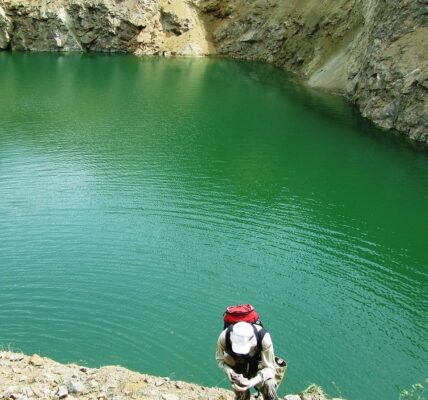Earthquakes are one of the most destructive natural phenomena on the planet. They can occur suddenly and cause severe damage, life-threatening hazards and huge economic losses. One of the key aspects of earthquake mitigation is predicting earthquakes, and this is where geology plays a central role. In this article, we detail how geology helps predict earthquakes by studying various aspects of the Earth’s crust and tectonic processes.
| Reason | Description |
| Tectonic processes | Movement of lithospheric plates, their collision, divergence or sliding relative to each other. |
| Volcanic activity | The movement of magma beneath the earth’s surface creates stresses that can cause earthquakes. |
| Pressure changesin the Earth’s crust | Abrupt change in pressure due to accumulation of tectonic stresses or other geophysical processes. |
| geological faults | Rock displacement along active crustal faults. |
| Landslides and karst processes | Collapse of underground cavities causing seismic shocks |
| Human activity | Explosions, mining, and the injection of fluids into deep wells can cause man-made earthquakes. |
Study of tectonic plates
One of the most important tasks of geology in earthquake prediction is to study the movement of tectonic plates. Tectonic plates are massive parts of the Earth’s lithosphere that move slowly across the surface of the mantle. These plates can collide, diverge, or slide against each other, and it is these interactions that cause most earthquakes.
Geologists study the mechanisms of tectonic plate movement to understand where and how stresses build up in the Earth’s crust. Strong earthquakes often occur at places where plates collide, such as the boundaries between the Eurasian and Indo-Australian plates. These stresses build up over decades or even centuries and at some point are released, causing earthquakes.
The study of plate motion involves the use of various geophysical techniques such as satellite geodesy, seismic tomography and observations of the deformation of the Earth’s surface. These techniques can accurately measure the speed and direction of plate motion, as well as track changes that may indicate the buildup of stresses in the Earth’s crust.
In addition, geologists use historical earthquake data to identify regions with the greatest seismic activity. This helps not only to understand where earthquakes have occurred in the past, but also to predict potentially hazardous areas in the future.
Thus, the study of tectonic plates is the basis for long-term earthquake prediction, which allows for mitigation measures such as the construction of earthquake-resistant buildings and infrastructure.
Greek online casinos provide a tailored gaming experience for players in Greece, offering a wide selection of games, bonuses, and localized payment options. These platforms are licensed and regulated, ensuring a safe and secure environment for players to enjoy their favorite casino games, including slots, table games, and live dealer experiences.
Seismic zoning
Another important aspect of geology in earthquake prediction is seismic zoning. This involves creating seismic hazard maps that show the potential risks of earthquakes in different regions. Geologists analyze data on past earthquakes, crustal structure and tectonic features to assess the level of hazard in specific locations.
Seismic zoning is based on historical earthquake frequency and intensity data. For example, regions such as the Pacific Ring of Fire, where oceanic and continental plates collide with high frequency, are included in high hazard zones. Such maps help local authorities and developers to consider risks and take measures to minimize damage from potential earthquakes.
One of the key objectives of seismic zoning is to assess the likelihood that a major earthquake will occur in a particular region within a certain time frame. This allows us to better prepare for disasters by developing evacuation plans and improving building codes and standards. In countries with high seismic activity, such as Japan and Chile, seismic zoning is used to develop building codes, helping to significantly reduce casualties and damage.
Also, geologists can create more detailed maps at the local level. This is especially important in urban agglomerations, where even the slightest fluctuations in the earth’s crust can cause significant damage. Thus, seismic zoning allows not only to assess general risks for regions, but also to plan construction and urban infrastructure taking into account possible earthquakes.
Monitoring of faults
Faults are zones in the Earth’s crust where rocks are ruptured and displaced by tectonic processes. These zones are major sources of earthquakes because they store stresses that are then suddenly released. Monitoring active faults is an important tool for short-term earthquake prediction.
Geologists study active faults to understand how quickly stresses build up in them and how often earthquakes occur in these zones. One of the most famous faults is the San Andreas Fault in California, which regularly generates damaging earthquakes. By studying fault activity and stress accumulation, the likelihood of new earthquakes occurring in the region can be estimated.
Modern monitoring technologies include the use of GPS stations that track even the smallest movements of the earth’s surface. This data allows geologists to monitor the deformations occurring in faults and assess the degree of risk. For example, if a fault begins to move actively, it may indicate that an earthquake is imminent.
Fault monitoring allows geologists not only to identify potentially dangerous zones, but also to track changes in seismic activity in real time. This is especially important for regions with high population density, where early warning of an earthquake can save lives. In some cases, modern monitoring systems can provide a warning a few seconds before an earthquake starts, giving people a chance to prepare.
Study of volcanic activity
Volcanic activity is closely related to earthquakes because the movement of magma beneath the Earth’s surface can create strong stresses in the Earth’s crust. Geologists study volcanoes and their activity to predict not only eruptions but also possible earthquakes associated with volcanic activity.
When magma rises to the surface, it fractures rocks, creating conditions for earthquakes. Such earthquakes tend to occur near active volcanoes. For example, areas surrounding volcanic zones often experience a series of small earthquakes that precede an eruption. These earthquakes are called volcano-tectonic earthquakes.
Geologists study not only active volcanoes, but also potentially dangerous volcanic zones where magmatic processes may be hidden underground. Studying volcanic activity also helps us understand how seismically active a region is. For example, in countries such as Iceland and Italy, where volcanic activity is a significant factor, geologists actively monitor seismic processes to predict both eruptions and possible earthquakes.
Monitoring volcanic activity involves seismic observation, measuring the deformation of the Earth’s surface, and analyzing the composition of gases released from the Earth’s interior. These data allow scientists to estimate the degree of volcanic activity and the likelihood of earthquakes associated with volcanic activity.
Interpretation of seismic data
1. Analyze seismograms: Interpret data recorded by seismographs to determine the strength and location of an earthquake.
2. epicenter determination: Using the arrival times of seismic waves at different stations to pinpoint the exact location of an earthquake.
3 Magnitude estimation: Measuring the amplitude and energy of seismic waves to calculate the magnitude of an earthquake.
4. wave type analysis: Examination of P-waves (primary) and S-waves (secondary) to understand earthquake damage and propagation.
5. Tomographic modeling: Using seismic data to build models of the Earth’s internal structure.
6. Identification of precursors: Identification of anomalous seismic shocks that may precede a larger earthquake.
7. Use of Early Warning Data: Interpretation of data to provide rapid warning of an approaching large earthquake.
8. Investigation of postseismic events: Analyzing data to study aftershocks that occur after the main earthquake.
One of the most important tasks of geology in earthquake prediction is the interpretation of seismic sensor data. Seismographs record vibrations in the Earth’s crust, which can be both the result of earthquakes and precursors to more powerful seismic events.
Geologists analyze this data to understand the nature and source of earthquakes. For example, if a series of shallow tremors are observed in an active fault zone, this may indicate that stresses are building up there and a larger earthquake may occur in the future.
In addition, interpretation of seismic data provides a better understanding of the structure of the Earth’s crust and the processes occurring at depth. For example, seismic tomography allows scientists to look deep into the Earth and see how seismic waves propagate through different rock layers. This data helps not only to predict earthquakes, but also to refine models of the Earth’s structure.
An important aspect of seismic data interpretation is the use of earthquake early warning systems. These systems work by analyzing the first seismic waves that reach the surface earlier than the main destructive waves. This makes it possible to give a warning a few seconds before strong vibrations begin, which may be enough to save lives.
Geology thus plays a key role in predicting earthquakes. The study of tectonic plates, faults, volcanic activity and the interpretation of seismic data allow scientists not only to predict earthquakes, but also to prepare societies for these natural disasters.




